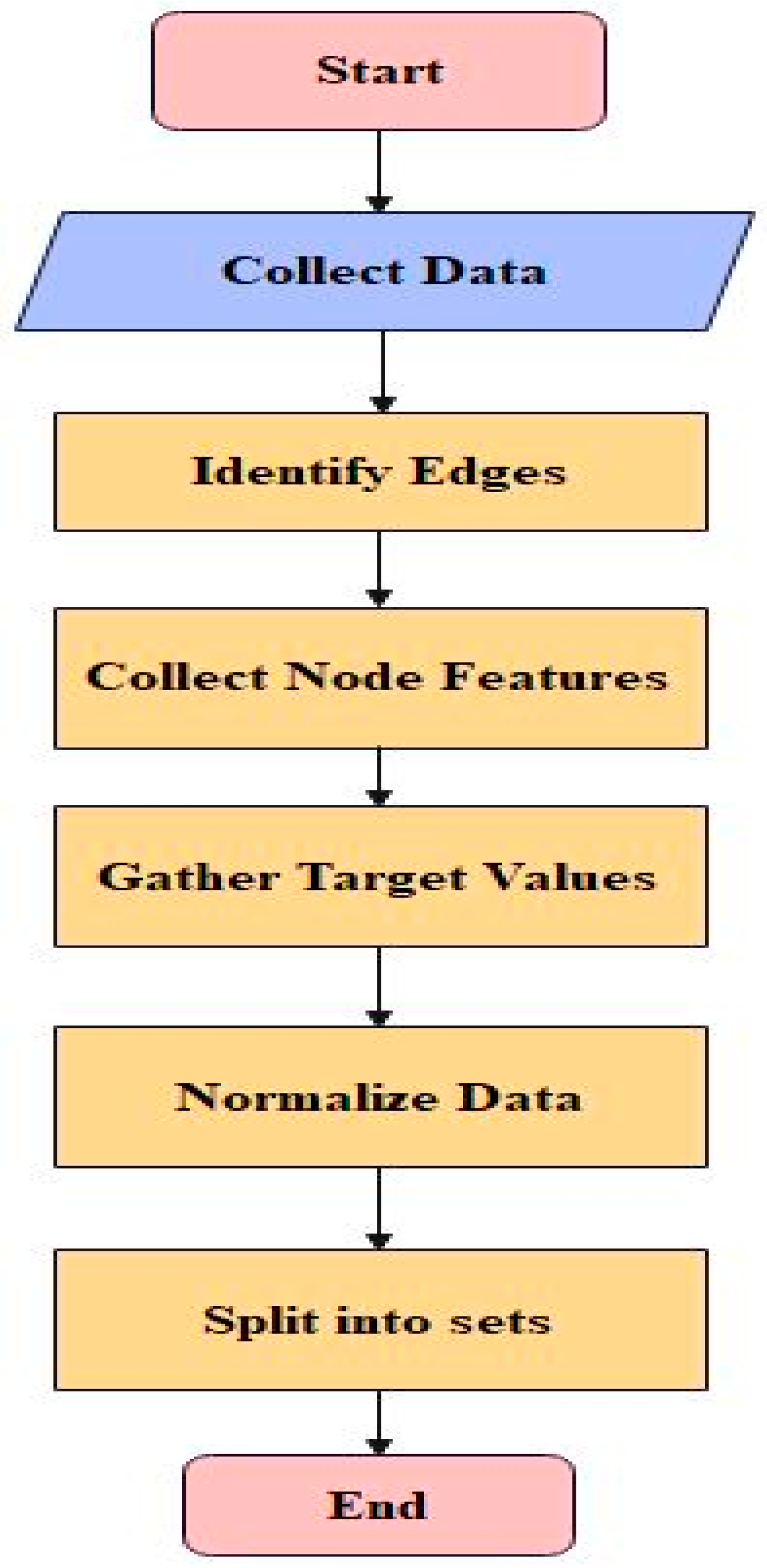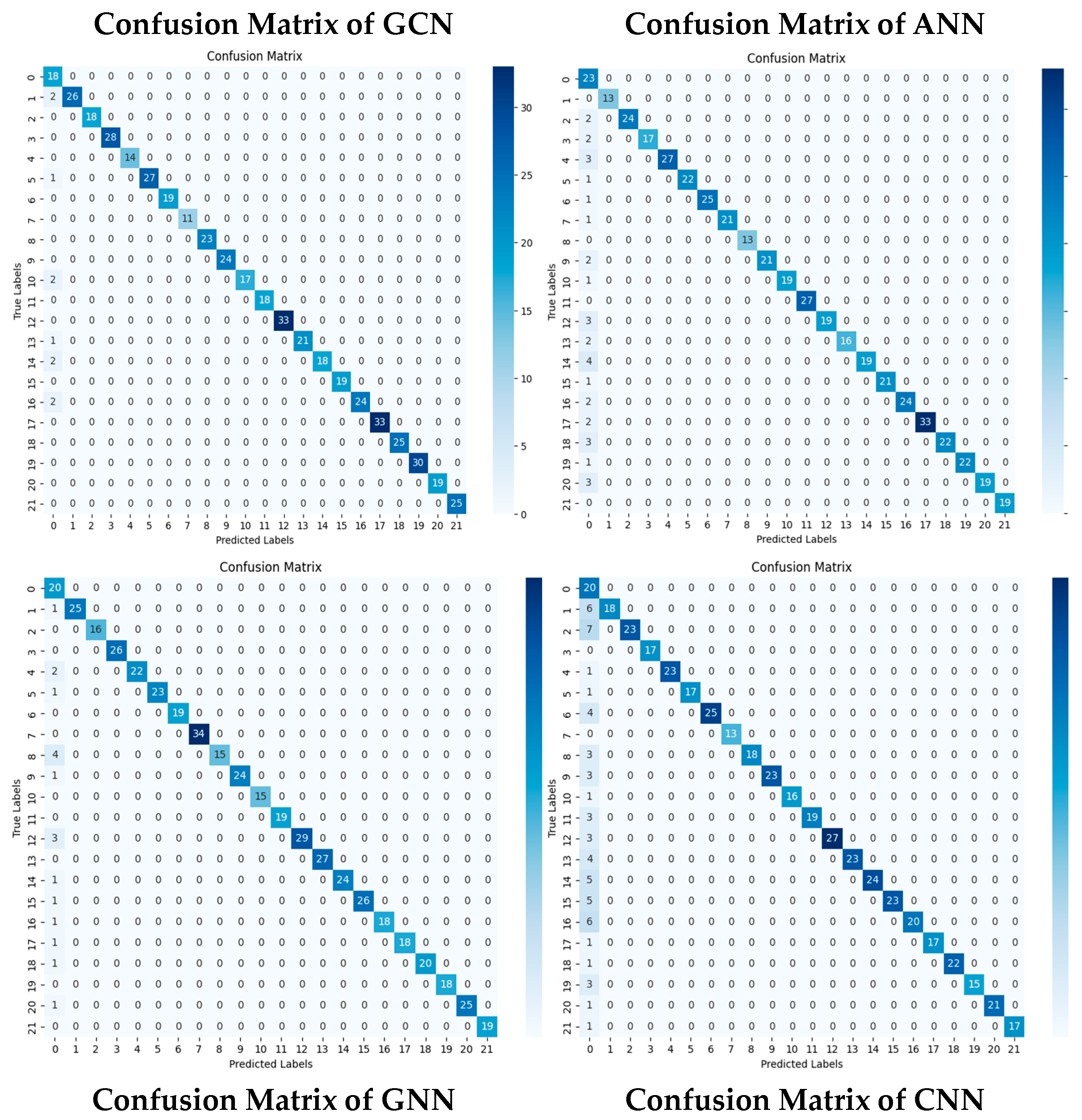Crop Recommendation Systems Based on Soil and Environmental Factors Using Graph Convolution Neural Network: A Systematic Literature Review †
Abstract
:1. Introduction
2. Background
2.1. Graph Convolution Network (GCN)
2.2. Graph Neural Network
3. Literature Review
4. Materials and Methods
4.1. Dataset
4.2. Data Preparation to Train GCN
4.3. Model Training
4.4. Model Evaluation
4.5. Performance Metrics
5. Results
6. Discussion
7. Conclusions
Author Contributions
Funding
Institutional Review Board Statement
Informed Consent Statement
Data Availability Statement
Conflicts of Interest
References
- Tugrul, B.; Elfatimi, E.; Eryigit, R. Convolutional Neural Networks in Detection of Plant Leaf Diseases: A Review. Agriculture 2022, 12, 1192. [Google Scholar] [CrossRef]
- Bandara, P.; Weerasooriya, T.; Ruchirawya, T.; Nanayakkara, W.; Dimantha, M.; Pabasara, M. Crop recommendation system. Int. J. Comput. Appl. 2020, 975, 8887. [Google Scholar] [CrossRef]
- Sivanandhini, P.; Prakash, J. Crop Yield Prediction Analysis using Feed Forward and Recurrent Neural Network. Int. J. Innov. Sci. Res. Technol. 2020, 5, 1092–1096. [Google Scholar]
- Pruthviraj; Akshatha, G.C.; Shastry, K.A.; Nagaraj; Nikhil. Crop and fertilizer recommendation system based on soil classification. In Recent Advances in Artificial Intelligence and Data Engineering, Proceedings of AIDE 2020, Karkala, India, 22–23 December 2020; Springer: Berlin/Heidelberg, Germany, 2022; pp. 29–40. [Google Scholar]
- Motwani, A.; Patil, P.; Nagaria, V.; Verma, S.; Ghane, S. Soil Analysis and Crop Recommendation using Machine Learning. In Proceedings of the 2022 International Conference for Advancement in Technology (ICONAT), IEEE, Goa, India, 21–22 January 2022; pp. 1–7. [Google Scholar]
- Sharma, A.; Bhargava, M.; Khanna, A.V. AI-Farm: A crop recommendation system. In Proceedings of the 2021 International Conference on Advances in Computing and Communications (ICACC), IEEE, Kochi, Kakkanad, India, 21–23 October 2021; pp. 1–7. [Google Scholar]
- Bandi, R.; Likhit, M.S.S.; Reddy, S.R.; Bodla, S.R.; Venkat, V.S. Voting Classifier-Based Crop Recommendation. SN Comput. Sci. 2023, 4, 516. [Google Scholar] [CrossRef]
- Fassa, V.; Pricca, N.; Cabassi, G.; Bechini, L.; Corti, M. Site-specific nitrogen recommendations’ empirical algorithm for maize crop based on the fusion of soil and vegetation maps. Comput. Electron. Agric. 2022, 203, 107479. [Google Scholar] [CrossRef]
- Shedthi, S.; Shetty, A.; Shetty, R.R.; Alva, B.A.D.; Shetty, A.D. Machine Learning Techniques in Crop Recommendation based on Soil and Crop Yield Prediction System–Review. In Proceedings of the 2022 International Conference on Artificial Intelligence and Data Engineering (AIDE), IEEE, Karkala, Karnataka, India, 22–23 December 2022; pp. 230–235. [Google Scholar]
- Hossain, D.; Kashem, M.A.; Mustary, S. IoT Based Smart Soil Fertilizer Monitoring and ML Based Crop Recommendation System. In Proceedings of the 2023 International Conference on Electrical, Computer and Communication Engineering (ECCE), London, UK, 11–12 December 2023; pp. 1–6. [Google Scholar]
- Banerjee, S.; Mondal, A.C. A Region-Wise Weather Data-Based Crop Recommendation System Using Different Machine Learning Algorithms. Int. J. Intell. Syst. Appl. Eng. 2023, 11, 283–297. [Google Scholar]
- Zhou, J.; Cui, G.; Hu, S.; Zhang, Z.; Yang, C.; Liu, Z.; Wang, L.; Li, C.; Sun, M. Graph neural networks: A review of methods and applications. AI Open 2020, 1, 57–81. [Google Scholar] [CrossRef]
- Zhu, J.; Rossi, R.A.; Rao, A.; Mai, T.; Lipka, N.; Ahmed, N.K.; Koutra, D. Graph neural networks with heterophily. In Proceedings of the AAAI Conference on Artificial Intelligence, Vancouver, BC, Canada, 2–9 February 2021; pp. 11168–11176. [Google Scholar]
- Zheng, X.; Liu, Y.; Pan, S.; Zhang, M.; Jin, D.; Yu, P.S. Graph neural networks for graphs with heterophily: A survey. arXiv 2022, arXiv:2202.07082. [Google Scholar]
- Wu, Z.; Pan, S.; Chen, F.; Long, G.; Zhang, C.; Yu, P.S. A comprehensive survey on graph neural networks. arXiv 2019, arXiv:1901.00596. [Google Scholar] [CrossRef] [PubMed]
- Scarselli, F.; Gori, M.; Tsoi, A.C.; Hagenbuchner, M.; Monfardini, G. The graph neural network model. IEEE Trans. Neural Netw. 2008, 20, 61–80. [Google Scholar] [CrossRef] [PubMed]
- Zhang, X.-M.; Liang, L.; Liu, L.; Tang, M.-J. Graph Neural Networks and Their Current Applications in Bioinformatics. Front. Genet. 2021, 12, 690049. [Google Scholar] [CrossRef] [PubMed]
- Chen, M.; Wei, Z.; Huang, Z.; Ding, B.; Li, Y. Simple and deep graph convolutional networks. In Proceedings of the International Conference on Machine Learning, PMLR, Virtual, 13–18 July 2020; pp. 1725–1735. [Google Scholar]
- Tong, Z.; Liang, Y.; Sun, C.; Rosenblum, D.S.; Lim, A. Directed graph convolutional network. arXiv 2020, arXiv:2004.13970. [Google Scholar]
- Ma, Y.; Hao, J.; Yang, Y.; Li, H.; Jin, J.; Chen, G. Spectral-based graph convolutional network for directed graphs. arXiv 2019, arXiv:1907.08990. [Google Scholar]
- Pande, S.M.; Ramesh, P.K.; Anmol, A.; Aishwarya, B.R.; Rohilla, K.; Shaurya, K. Crop Recommender System Using Machine Learning Approach. In Proceedings of the 2021 5th International Conference on Computing Methodologies and Communication (ICCMC), Erode, India, 8–10 April 2021; pp. 1066–1071. [Google Scholar]
- Rupnik, R.; Kukar, M.; Vračar, P.; Košir, D.; Pevec, D.; Bosnić, Z. AgroDSS: A decision support system for agriculture and farming. Comput. Electron. 2009, 161, 260–271. [Google Scholar] [CrossRef]
- Doshi, Z.; Nadkarni, S.; Agrawal, R.; Shah, N. AgroConsultant: Intelligent Crop Recommendation System Using Machine Learning Algorithms. In Proceedings of the 2018 Fourth International Conference on Computing Communication Control and Automation (ICCUBEA), Pune, India, 16–18 August 2018; pp. 1–6. [Google Scholar]
- Pudumalar, S.; Ramanujam, E.; Rajashree, R.H.; Kavya, C.; Kiruthika, T.; Nisha, J. Crop recommendation system for precision agriculture. In Proceedings of the 2016 Eighth International Conference on Advanced Computing (ICoAC), Chennai, India, 19–21 January 2017; pp. 32–36. [Google Scholar] [CrossRef]
- Reddy, D.A.; Dadore, B.; Watekar, A. Crop Recommendation System to Maximize Crop Yield in Ramtek region using Machine Learning. Int. J. Sci. Res. Sci. Technol. 2019, 6, 485–489. [Google Scholar] [CrossRef]
- Thilakarathne, N.N.; Abu Bakar, M.S.; Abas, P.E.; Yassin, H. A Cloud Enabled Crop Recommendation Platform for Machine Learning-Driven Precision Farming. Sensors 2022, 22, 6299. [Google Scholar] [CrossRef] [PubMed]
- Chakraborty, S.; Mishra, S. A Smart Farming-Based Recommendation System Using Collaborative Machine Learning and Image Processing. In Cognitive Informatics and Soft Computing, Proceedings of CISC 2021, Balasore, India, 21–22 August 2021; Springer: Singapore, 2022; pp. 703–716. [Google Scholar]
- Jiang, Y.; Li, C. Convolutional Neural Networks for Image-Based High-Throughput Plant Phenotyping: A Review. Plant Phenomics 2020, 2020, 4152816. [Google Scholar] [CrossRef] [PubMed]
- Cuevas, J.; Daliakopoulos, I.N.; del Moral, F.; Hueso, J.J.; Tsanis, I.K. A Review of Soil-Improving Cropping Systems for Soil Salinization. Agronomy 2019, 9, 295. [Google Scholar] [CrossRef]
- Yang, T.; Siddique, K.H.; Liu, K. Cropping systems in agriculture and their impact on soil health—A review. Glob. Ecol. Conserv. 2020, 23, e01118. [Google Scholar] [CrossRef]




| Model | Accuracy | Precision | Recall | F1-Score | Specificity | Sensitivity |
|---|---|---|---|---|---|---|
| GCN | 0.98 | 0.98 | 0.97 | 0.97 | 0.99 | 0.97 |
| GNN | 0.96 | 0.97 | 0.95 | 0.96 | 0.99 | 0.95 |
| ANN | 0.93 | 0.96 | 0.93 | 0.94 | 0.99 | 0.93 |
| CNN | 0.88 | 0.96 | 0.89 | 0.91 | 0.99 | 0.89 |
Disclaimer/Publisher’s Note: The statements, opinions and data contained in all publications are solely those of the individual author(s) and contributor(s) and not of MDPI and/or the editor(s). MDPI and/or the editor(s) disclaim responsibility for any injury to people or property resulting from any ideas, methods, instructions or products referred to in the content. |
© 2023 by the authors. Licensee MDPI, Basel, Switzerland. This article is an open access article distributed under the terms and conditions of the Creative Commons Attribution (CC BY) license (https://creativecommons.org/licenses/by/4.0/).
Share and Cite
Ayesha Barvin, P.; Sampradeepraj, T. Crop Recommendation Systems Based on Soil and Environmental Factors Using Graph Convolution Neural Network: A Systematic Literature Review. Eng. Proc. 2023, 58, 97. https://doi.org/10.3390/ecsa-10-16010
Ayesha Barvin P, Sampradeepraj T. Crop Recommendation Systems Based on Soil and Environmental Factors Using Graph Convolution Neural Network: A Systematic Literature Review. Engineering Proceedings. 2023; 58(1):97. https://doi.org/10.3390/ecsa-10-16010
Chicago/Turabian StyleAyesha Barvin, P., and T. Sampradeepraj. 2023. "Crop Recommendation Systems Based on Soil and Environmental Factors Using Graph Convolution Neural Network: A Systematic Literature Review" Engineering Proceedings 58, no. 1: 97. https://doi.org/10.3390/ecsa-10-16010
APA StyleAyesha Barvin, P., & Sampradeepraj, T. (2023). Crop Recommendation Systems Based on Soil and Environmental Factors Using Graph Convolution Neural Network: A Systematic Literature Review. Engineering Proceedings, 58(1), 97. https://doi.org/10.3390/ecsa-10-16010






